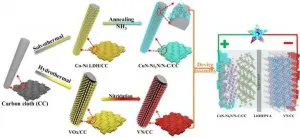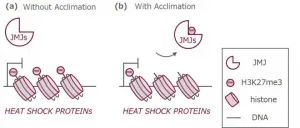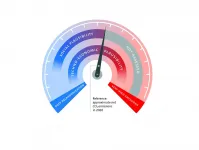(Press-News.org) Fast radio bursts, or FRBs, blaze for a few milliseconds before vanishing without a trace. Their origins are unknown, and their appearance is unpredictable. In the decade following their discovery in 2007, only 140 FRBs had been seen. Now, thanks to the launch of a large stationary telescope in the interior of British Columbia in 2018, the number of new FRBs detected has almost quadrupled - for a total of 535. Moreover, the Canadian Hydrogen Intensity Mapping Experiment (CHIME/FRB), a McGill-led inter-university collaboration, has put together the first CHIME/FRB catalogue, which will be presented this week at the American Astronomical Society Meeting.
CHIME is unique in that it observes the entire Northern sky once every day. Signals from over a thousand antennas are digitally processed in real time to enable high sensitivity measurements over a wide range of frequencies. It is already yielding clues about the properties of FRBs. For instance, there may be distinct types of FRB events, based on the shape of the burst and the range of radio frequencies it comprises.
Different astrophysical qualities underlying different classes of FRBs?
Among the 535 FRBs in the new CHIME/FRB catalogue, scientists have identified 18 FRB sources that burst repeatedly, while the rest appear to be one-offs. The repeaters also look different, with each burst lasting slightly longer and emitting more focused radio frequencies than bursts from single, non-repeating FRBs.
"In some cases, it takes thousands of hours of observations to detect a single burst from some FRBs, while others have repeated within the span of tens of hours," says Pragya Chawla, a PhD candidate in the McGill Physics Department. "Our current sample indicates that there are significant differences in the properties of repeaters and non-repeaters and future studies will allow us to determine whether the two kinds of events are generated by different astrophysical phenomena."
FRBs may be distributed across the Sky
From the FRBs that CHIME has detected, the scientists have calculated that bright fast radio bursts occur at a rate of about 800 per day -- the most precise estimate of FRBs overall rate to date. When they started mapping the locations of the FRBs seen between 2018-2019, the researchers found that the bursts were distributed uniformly across the sky, suggesting that the FRB population is spread throughout the Universe and not located simply in our Milky Way galaxy. For each of the 535 FRBs that CHIME detected, the researchers measured its dispersion, and found that most bursts likely originated from far-off sources within distant galaxies.
The fact that the bursts were bright enough to be detected by CHIME suggests that they must have been produced by extremely energetic sources. With more observations, astronomers hope to pin down the extreme origins of these curiously bright signals soon.
"FRBs also carry information about the medium that they travel through," adds Saurabh Singh, a postdoctoral researcher in McGill's Physics Department. "With the significant increase in their detections over a range of distances from us, they potentially offer an independent measurement of matter distribution in the Universe."
As radio waves travel across space, any interstellar gas, or plasma, along the way can distort or disperse the wave's properties and trajectory. The degree to which a radio wave is dispersed can give clues to how much gas it passed through, and possibly to how much distance it has traveled from its source. The researchers also plan to use the bursts, and their dispersion estimates, to map the distribution of gas throughout the universe.
An FRB detection machine - looking both far and near
Scientists are only beginning to explore the rich world of FRBs thanks to observations from CHIME. "Having a large sample of FRBs unlocks countless possibilities. As one example, we are now in the era of using FRBs as cosmological probes," says Alex Josephy, a PhD student in Physics at McGill. "We can begin examining large-scale structures -- clusters of thousands of galaxies. We can help map the distribution of cosmic dark matter and study the evolution of matter throughout our Universe's history."
"Nearby FRBs, such as some of those described in this CHIME/FRB catalog are inarguably the best sources to test models of the origins and properties of FRBs," adds Mohit Bhardwaj, a PhD student in the McGill Physics Department. "If we want to learn the most about FRBs, like if they shine in optical or X-ray light, nearby FRBs are our best options!"
As the telescope detects more FRBs, scientists hope to pin down more clearly exactly what kind of exotic phenomena could generate these ultrabright, ultrafast signals.
INFORMATION:
About CHIME
CHIME comprises four massive cylindrical radio antennas, roughly the size and shape of snowboarding half-pipes, located at the Dominion Radio Astrophysical Observatory, operated by the National Research Council of Canada in British Columbia, Canada. CHIME is a stationary array, with no moving parts. The telescope receives radio signals each day from half of the sky as the Earth rotates. While most radio astronomy is done by swivelling a large dish to focus light from different parts of the sky, CHIME stares, motionless, at the sky, and focuses (on?) incoming signals using a correlator -- a powerful digital signaling processor that can work through huge amounts of data, at a rate of about seven terabits per second, equivalent to a few percent of the world's internet traffic.
About McGill University
Founded in Montreal, Quebec, in 1821, McGill University is Canada's top ranked medical doctoral university. McGill is consistently ranked as one of the top universities, both nationally and internationally. It is a world-renowned institution of higher learning with research activities spanning two campuses, 11 faculties, 13 professional schools, 300 programs of study and over 40,000 students, including more than 10,200 graduate students. McGill attracts students from over 150 countries around the world, its 12,800 international students making up 31% of the student body. Over half of McGill students claim a first language other than English, including approximately 19% of our students who say French is their mother tongue.
The research was funded by various institutions including the Canada Foundation for Innovation, the Provinces of Quebec and British Columbia, the Dunlap Institute for Astronomy and Astrophysics at the University of Toronto, the Canadian Institute for Advanced Research, McGill University and the McGill Space Institute via the Trottier Family Foundation, and the University of British Columbia.
Contact:
Katherine Gombay
Media Relations Office, McGill University
+1 (514) 717-2289
katherine.gombay@mcgill.ca
http://www.mcgill.ca/newsroom/
http://twitter.com/McGillU
Subscribe to receive news about McGill's experts and research
Visit the McGill Newsroom for more information
Recently, a research team led by Prof. ZHAO Bangchuan from the Institute of Solid Materials of the Hefei Institutes of Physical Science (HFIPS) synthesized 3D porous honeycomb-like CoN-Ni3N/N-C nanosheets and vanadium nitride (VN) nanobelt arrays via in-situ growth method, respectively, and constructed a high-energy-density flexible supercapacitor device. The result has been published in Advanced Functional Materials.
Transition metal nitrides (TMNs) are potential electrode materials for high-performance energy storage devices, but the structural instability severely hinders their application. Therefore ...
Ikoma, Japan - "If you can't stand the heat, get out of the kitchen," as the old saying goes. But for organisms that can't leave the proverbial kitchen when things get too hot, there's another way: researchers from Japan have discovered that plants can gain heat tolerance to better adapt to future heat stress, thanks to a particular mechanism for heat stress 'memory'.
In a study published in Nature Communications, researchers from Nara Institute of Science and Technology have revealed that a family of proteins that control small heat shock genes enables plants to 'remember' how to deal with heat stress.
Climate change, especially global warming, is a growing threat to agriculture ...
Prostate cancer is the most common form of cancer among Canadian men and the third leading cause of cancer death. Abdominal obesity appears to be associated with a greater risk of developing aggressive prostate cancer. This link was demonstrated in a END ...
Generally, physics and financial systems are not easily associated in people's minds. Yet, principles and techniques originating from physics can be very effective in describing the processes taking place on financial markets. Modeling financial systems as networks can greatly enhance our understanding of phenomena that are relevant not only to researchers in economics and other disciplines, but also to ordinary citizens, public agencies and governments. And the theory of Complex Networks represents a powerful framework for studying how shocks propagate in financial systems, identifying early-warning signals of forthcoming crises, and reconstructing ...
Today the Hamburg-based Cluster of Excellence "Climate, Climatic Change, and Society" (CLICCS) publishes a new, essential study on climate futures. The study represents the first systematic attempt to investigate whether a climate future with net-zero carbon emissions is not only possible but also plausible. The authors examine plausibility from a technical-economic perspective, but also with regard to the societal changes necessary for such a future. They conclude that deep decarbonization by 2050 is currently not plausible - the current efforts to bring about societal transformation need to be far more ambitious.
The European Union is now increasing the ambition of its climate goals, and the German Federal Constitutional Court has recently committed Germany ...
Researchers have created a plant-based, sustainable, scalable material that could replace single-use plastics in many consumer products.
The researchers, from the University of Cambridge, created a polymer film by mimicking the properties of spider silk, one of the strongest materials in nature. The new material is as strong as many common plastics in use today and could replace plastic in many common household products.
The material was created using a new approach for assembling plant proteins into materials which mimic silk on a molecular level. The energy-efficient method, which uses sustainable ingredients, results in a plastic-like free-standing film, which can be made at industrial ...
Researchers from North Carolina State University have turned a longstanding challenge in DNA data storage into a tool, using it to offer users previews of stored data files - such as thumbnail versions of image files.
DNA data storage is an attractive technology because it has the potential to store a tremendous amount of data in a small package, it can store that data for a long time, and it does so in an energy-efficient way. However, until now, it wasn't possible to preview the data in a file stored as DNA - if you wanted to know what a file was, you had to "open" the entire file.
"The advantage to our technique is that it is more efficient ...
DALLAS, June 10, 2021 -- The distance a stroke patient must travel to receive care at a certified stroke center differs by race, age, income and insurance status, with the largest disparities found among rural residents and American Indians, according to a combined analysis of U.S. census data and road maps published today in Stroke, a journal of the American Stroke Association, a division of the American Heart Association.
Treatment for ischemic stroke, a blockage in an artery that supplies blood to the brain, restores blood flow to the brain. Rapid treatment is essential to reduce disability. Blood flow may be reestablished by administering intravenous clot-busting medication within 4.5 hours after the onset of stroke ...
Polymetallic nodules and crusts cover many thousands of square kilometres of the world's deep-sea floor. They contain valuable metals and rare earth elements and are therefore of great economic interest. To date, there is no market-ready technology for deep-seabed mining. But it is already clear that interventions in the seabed have a massive and lasting impact on the areas affected. This is also confirmed by a study now published by Tanja Stratmann from the Max Planck Institute for Marine Microbiology in Bremen, Germany, and researchers from the Senckenberg am Meer Institute in Wilhelmshaven, Germany, and the Dutch research institute NIOZ.
In their study, Stratmann and her colleagues used data from ...
When nature vanishes, people of color and low-income Americans disproportionally lose critical environmental and health benefits--including air quality, crop productivity and natural disease control--a new study in Nature Communications finds.
The University of Vermont research is the first national study to explore the unequal impacts on American society--by race, income and other demographics--of projected declines in nature, and its many benefits, across the United States.
Focusing on three vital ecosystem services--air quality, crop pollination, and control of insect-borne disease (West Nile virus), researchers project that these benefits of nature will decrease for non-white people by an average of 224%, ...




